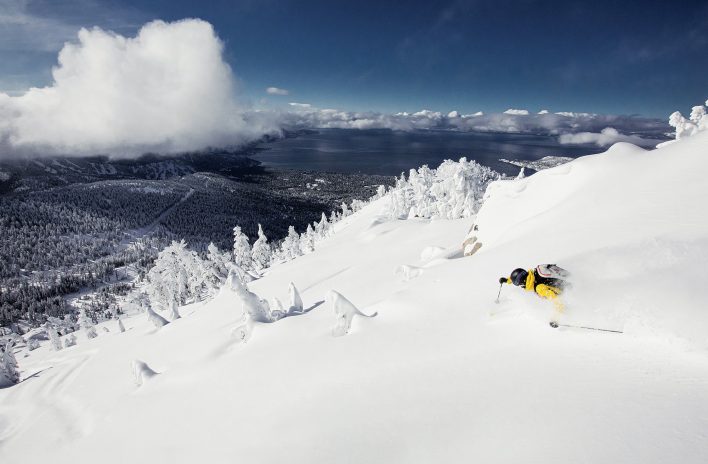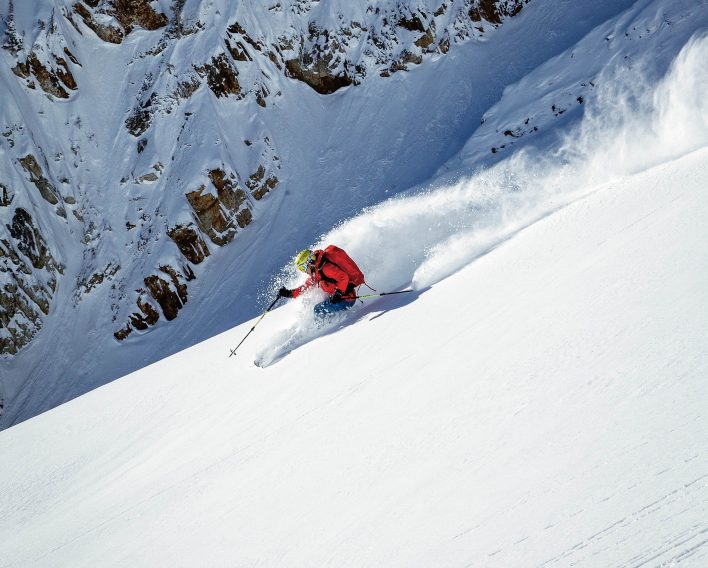I take terrible touring photos. From an island of safety, I’ll shoot with reckless abandon at a friend, often ignoring the few tenets of photography I do know (looking at you, Rule of Thirds). Occasionally, quantity begets quality, and a passable image stands out, but in general that’s through luck, not skill. Maybe that’s true for you as well, but, according to professional photographers and athletes, it doesn’t have to be that way.

Emily Tidwell demonstrates how to frame a shot while Amie Engerbretson takes advantage of a sunny, deep pow lap in California’s Mt. Rose Wilderness. [Photo] Emily Tidwell
Behind the Lens
A good photo starts with avalanche awareness. “Something to always be cognizant of is snow safety for both you and your subject,” photographer Emily Tidwell says. Then comes planning. “I’m constantly thinking about imagery as I’m going up a skintrack,” she continues. As you tour, especially if you’ll descend the same way, look for features, snow surfaces and views that you’d like in a photo. Once you’ve identified your spot and angle, make sure you and your subjects are on the same page. “If you don’t effectively communicate what you’re envisioning to the skier, it’s not going to pan out,” photographer Katie Cooney says.
You can communicate your idea to an athlete in several ways. Discussing the shot on the way up may be the most effective, but if you can’t do that, radios are handy to let a subject know the best place to lay a carve. Cooney uses a more analog method, too, when she’s below an athlete. “If you can toss a snowball and say, ‘Right about there,’ that’s usually a really good way to communicate,” she says.
Once you’re in position, play around with the angle. Get low or move around in your safe zone to find the most compelling frame. High points, like ridges or rock bands, offer great vantages. Tidwell suggests including pieces of the landscape—branches, trees, rocks—in your foreground to provide depth and context. If you’re using an iPhone, turn on burst mode (called Burst Shot on a Samsung), so you can take several photos of a skier or rider then choose the best one. “That’s why we say shoot everything: You just have to decide what looks cool to you,” Cooney says.
Finally, you don’t need a DSLR to customize your photos. Newer smartphone cameras allow users to change the exposure, adjust the warmth of an image, which alters the colors that are highlighted, and use many other tools found on actual cameras, so familiarize yourself with your phone’s options. For those really interested in manually manipulating their camera, Cooney says apps like Pro Camera from Moment offer a full range of tools, and small, snap-on lenses can be useful for creating the correct framing and depth of field. “If someone is really into it, I suggest finding an editing software they like, too,” she says.

Caroline Gleich says gathering speed to “blow up the snow” near the camera is an art form. Here on Utah’s Mt. Superior, she gives a master class. [Photo] Louis Arévalo
Skiing for the Camera
The photographer is only half the equation in getting a good shot. Being in front of the camera requires an understanding of where to turn for the best shot, but one thing in particular can improve a photo. “What I care about most is form,” Tidwell says. “For people who have to ski for the camera, if you want it to look good, an athletic stance is your Lord and Savior.”
If nothing else, keep your hands low and out front, says skier Caroline Gleich, who has spent plenty of time in front of and behind the camera. Nose your pole out front for a pop of color, but not so much that it looks like a weird chicken wing. For snowboarders, be aware of where your hands are and try to keep them low, rather than raised like a congregant speaking in tongues. Especially for blower-pow shots, ski or ride aggressively as you approach your spot. “It’s definitely an art form where you drop in and try to get as much speed as you can, so you can really blow up the snow,” Gleich says.
Beyond simply minding your Ps and Qs by zipping up your jacket, tightening backpack straps, cinching your jacket cuffs over your gloves and the like, Gleich says ease into shooting. “Start small and work your way up,” she says. “Start on a test slope; you know, the body’s got to warm up. So, your first shot, it’s OK to not nail it.”
Remember to Have Fun
According to one study, Americans spend an average of 1,300 hours on social media (where many recreational ski photos end up) each year, so there is an argument for simply leaving your phone in your pack and enjoying a tour. However, photos can be reminders of favorite tours long after winter is over, and, Gleich says, with a little self-awareness, they can be the impetus for a tour. “I don’t think there’s anything wrong in being motivated to do something for the ’Gram,” she says. “If your motivation is to get a shot for social media, that’s fine, as long as you’re aware of the human factors and how those play in.”
One way to remove the pressure of getting the perfect ski shot and capture the entirety of a trip or tour is to also take photos of the in-between moments. A perusal of Gleich’s Instagram account shows pictures and videos of packing, traveling and tending to the mundanities of expedition skiing. “It is really fun to try to tell the other parts of the stories,” she says. For someone who might not travel to Pakistan and other far-flung places on ski trips, she still suggests snapping photos of everything, from lugging ski bags through the airport to debriefing over beers at the trailhead.
Above all, these photographers suggest you don’t lose sight of the reason you’re taking photos in the first place—being in the mountains. Shooting a great image can lead to what Cooney calls “secondhand stoke,” but stopping to plan and take photos changes the cadence of a tour, limiting the number of laps or making a single-lap day take longer. Cooney and Tidwell both say they sometimes leave their cameras at home to create balance between taking photos and having fun skiing. Though that’s not a problem a recreational athlete might have, it’s a good reminder to not spend all day trying to get the shot.
Cooney suggests taking photos for part of a run, then putting the camera or phone away and ripping with your friends. In the end, she says, “I tell everyone I shoot with to smile and remember to have fun.”
This article was originally published in The 2023 Photo Annual. To read more, pick up a copy at BackcountryMagazine.com/148 or subscribe.










Related posts: